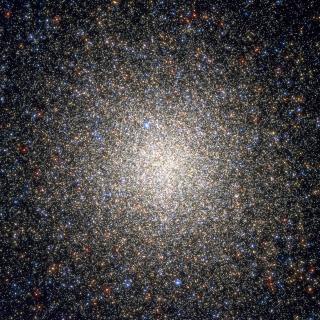Lardo, C.; Milone, A. P.; Marino, A. F.; Mucciarelli, A.; Pancino, E.; Zoccali, M.; Rejkuba, M.; Carrera, R. J.; Gonzalez, O.
Referencia bibliográfica
Astronomy and Astrophysics, Volume 541, id.A141
Fecha de publicación:
5
2012
Revista
Número de citas
45
Número de citas referidas
39
Descripción
We present the first chemical analysis of stars on the double subgiant
branch (SGB) of the globular cluster NGC 1851. We obtained 48 Magellan
IMACS spectra of subgiants and fainter stars covering the spectral
region between 3650-6750 Å to derive C and N abundances from the
spectral features at 4300 Å (G-band) and at ~3883 Å (CN). We
added to our sample ~45 unvevolved stars previously observed with FORS2
at the VLT. These two datasets were homogeneously reduced and analyzed.
We derived abundances of C and N for a total of 64 stars and found
considerable star-to-star variations in both [C/H] and [N/H] at all
luminosities extending to the red giant branch (RGB) base (V ~ 18.9).
These abundances appear to be strongly anticorrelated, as would be
expected from the CN-cycle enrichment, but we did not detect any
bimodality in the C or N content. We used Hubble space telescope (HST)
and ground-based photometry to select two groups of faint- and
bright-SGB stars from the visual and Strömgren color-magnitude
diagrams. Significant variations in the carbon and nitrogen abundances
are present among stars of each group, which indicates that each SGB
hosts multiple subgenerations of stars. Bright- and faint-SGB stars
differ in the total C+N content, where the fainter SGB have about 2.5
times the C+N content of the brighter ones. Coupling our results with
literature photometric data and abundance determinations from
high-resolution studies, we identify the fainter SGB with the red-RGB
population, which also should be richer on average in Ba and other
s-process elements, as well as in Na and N, when compared to brighter
SGB and the blue-RGB population.
Based on observations taken with the 6.5 meter Magellan Telescope at Las
Campanas Observatory, Chile and with the Very Large Telescope at ESO La
Silla Paranal Observatory, Chile, under programme ID 68.D-0510.
Proyectos relacionados

Vía Láctea y galaxias cercanas
El objetivo general del Proyecto es el estudio de la estructura, historia evolutiva y proceso de formación de galaxias a través de sus poblaciones estelares resueltas, tanto a partir de fotometría como espectroscopia. El proyecto puede dividirse en cuatro líneas principales: I. Historia de formación estelar en el Grupo Local. El objetivo de esta
Martín
López Corredoira